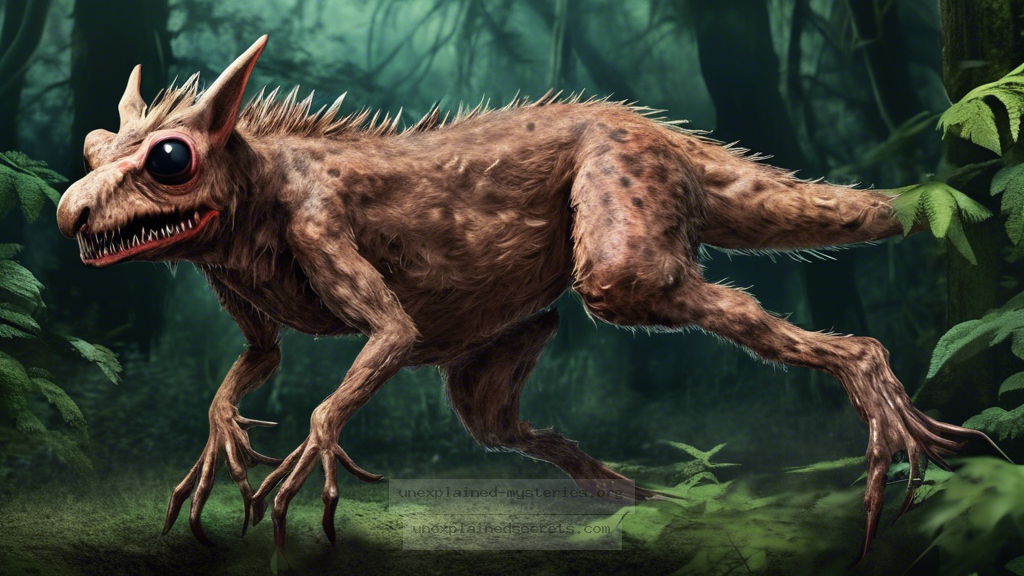Could the Chupacabra Be the Missing Link in Cryptozoology?
Could the Chupacabra Be the Missing Link in Cryptozoology?
The Chupacabra, a creature steeped in mystery, has tantalized cryptozoologists and enthusiasts alike since its rise to fame in the 1990s. But what exactly is this elusive being, and could it represent a missing link in our understanding of cryptozoology? This question matters because it challenges the boundaries between legend and reality, between myth and documented species. The Chupacabra’s story intertwines history, biology, and folklore, making it a compelling subject for exploration.
Historical Context: The Emergence of the Chupacabra
The Chupacabra, which translates to “goat-sucker” in Spanish, first gained notoriety in Puerto Rico in the mid-1990s. Reports of livestock being drained of blood with puncture wounds on their necks began to flood in, leading to widespread panic among farmers. The term “Chupacabra” was coined by Puerto Rican journalist, Silverio Pérez, who covered the story extensively. Eyewitness accounts described a creature that was small, spiky, and reptilian in appearance, contrasting sharply with typical fauna known to inhabit the region.
The phenomenon quickly spread beyond Puerto Rico, with sightings reported in the United States, Latin America, and even parts of Europe. As the Chupacabra legend grew, it became a cultural icon, representing rural fears and the unknown. Its mysterious nature invites speculation about its origins, leading to various theories ranging from undiscovered species to government experiments gone awry.
Core Concepts in Chupacabra Research
The study of the Chupacabra encompasses several core concepts within cryptozoology, including the classification of cryptids, the interaction between folklore and biology, and the examination of unexplained phenomena. Central to understanding the Chupacabra is the debate over its classification: is it a distinct species, or simply a misidentified known animal?
Some researchers argue that the Chupacabra could be a new species of canid, possibly a dog or coyote suffering from mange, which can cause hair loss and a gaunt appearance. Others suggest it might be a type of wild cat or even a new kind of primate. The ambiguity surrounding its classification highlights the challenges cryptozoologists face when attempting to validate claims about unknown creatures.
Practical Implications: Evidence and Sightings
Documented sightings of the Chupacabra serve as both evidence and a point of contention within the cryptozoological community. In 2005, in the town of Cuero, Texas, residents reported seeing a creature that matched the Chupacabra description. Local authorities investigated, leading to the discovery of several dead animals with unusual injuries. However, the investigation concluded that the animals were likely killed by domestic dogs, not a mysterious creature.
Despite the skepticism, there have been numerous sightings documented across the Americas. A notable case occurred in 2010 in Puerto Rico, where a farmer claimed to have encountered a Chupacabra while checking on his livestock at night. He described the creature as having large, glowing red eyes and sharp claws. While such anecdotes are often dismissed as exaggeration or error, they nonetheless fuel the ongoing intrigue surrounding the Chupacabra.
Alternative Perspectives: Skeptics vs. Believers
The Chupacabra debate illustrates a broader conflict between skeptical and believer perspectives. Skeptics argue that many reports can be attributed to misidentification, psychological factors, or even hoaxes. Studies have shown that eyewitness accounts can be unreliable, influenced by cultural narratives and personal biases. In contrast, believers point to the sheer volume of sightings and anecdotal evidence as indicators of the creature’s existence.
This divide raises essential questions about the nature of evidence. What constitutes acceptable proof in cryptozoology, and can folklore coexist with scientific rigor? The Chupacabra serves as a case study in how cultural narratives shape our understanding of the natural world, showcasing the tension between myth and reality.
Common Misconceptions: Debunking Myths
Several misconceptions about the Chupacabra persist in popular culture. One common myth is that the Chupacabra is an alien creature. While some enthusiasts have speculated about extraterrestrial origins, there is no substantive evidence to support this claim. Instead, most researchers focus on earthly explanations, exploring the creature’s potential genetic or environmental origins.
Another misconception is that all Chupacabra sightings describe the same creature. In reality, descriptions vary widely; some witnesses report a small, reptilian creature, while others describe a more canine-like beast. This variability suggests that multiple factors may be at play, including regional variations in folklore and the possibility of different creatures being misidentified as Chupacabras.
Best Practices for Investigation and Study
For those interested in investigating Chupacabra sightings, certain best practices can enhance the credibility of research. First, maintaining a healthy skepticism while remaining open-minded is crucial. Researchers should approach eyewitness accounts with a critical eye, assessing the context and possible influences on the observer.
Additionally, documenting findings meticulously is vital. Utilizing photographs, video evidence, and physical samples can provide valuable data for analysis. Collaborating with local wildlife experts can also offer insights into known species in the area, aiding in the identification of potential misidentifications.
Future Developments and Ongoing Research
The Chupacabra continues to capture the imagination of researchers and enthusiasts alike, prompting ongoing investigations and discussions. Advances in genetic testing and wildlife tracking technology may soon provide new avenues for exploration. For instance, scientists can analyze hair samples or biological material collected from alleged Chupacabra sightings to determine genetic relationships with known species.
Moreover, the rise of citizen science—where everyday people contribute to scientific research—can enhance the body of knowledge surrounding cryptids. Programs that encourage the public to report sightings and submit evidence can lead to a more comprehensive understanding of the Chupacabra phenomenon.
Conclusion: The Chupacabra’s Place in Cryptozoology
In summary, the question of whether the Chupacabra could be the missing link in cryptozoology invites exploration into the intersections of folklore, biology, and human perception. While skeptics may dismiss it as myth, the numerous sightings and cultural significance cannot be overlooked. The Chupacabra embodies the mystery of the unknown, urging us to question what we know about our natural world.
As research continues and techniques evolve, we may yet uncover the truth behind this enigmatic creature. Whether it exists as a distinct species or remains a product of folklore, the Chupacabra will undoubtedly continue to be a focal point of fascination within the cryptozoological community.
Other Articles
Recent Posts
- What Happened to Flight MH370? The Conspiracy Theories That Still Haunt Us
- What Secrets Lurk Within the Walls of the Infamous Trans-Allegheny Lunatic Asylum?
- What Evidence Supports the Existence of Bigfoot in the Pacific Northwest?
- What Happened to the Indus Valley Civilization? Unraveling the Mysteries of Ancient Urban Life
- Can Telepathy Be Scientifically Proven Through Laboratory Evidence?







